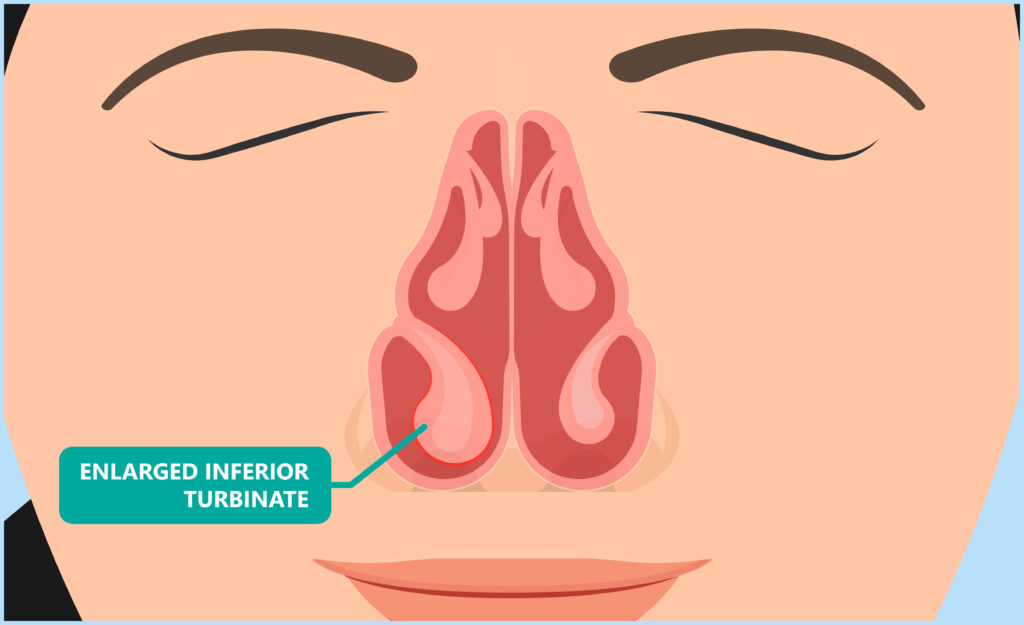
Do you constantly struggle to breathe through your nose? Are you tired of chronic nasal congestion that persists despite medication?
You may be experiencing the effects of enlarged turbinates, a common but often overlooked condition that can significantly impact your quality of life. However, with turbinate reduction, you can breathe easier again and experience long-term relief.
Keep reading to learn more about what happens during turbinate reduction and whether this procedure could be right for you.
What are Enlarged Turbinates?
Nasal turbinates play a crucial role in your respiratory health. These small, shell-shaped bony structures lined with soft tissue and mucous membrane serve as your body’s natural air conditioning system, performing several essential functions:
- Warming incoming air to body temperature
- Humidifying dry air before it reaches your lungs
- Filtering particulates, allergens, and pollutants
- Regulating airflow through your nasal passages
There are three pairs of turbinates: inferior, middle, and superior turbinates. The inferior turbinates, positioned at the lowest part of the nasal passage, are the largest and most susceptible to inflammation and enlargement.
What are the Symptoms of Enlarged Turbinates?
Turbinates can become enlarged or swollen, narrowing the nasal passages, restricting airflow, and causing symptoms like:

- Persistent nasal congestion
- Trouble breathing through the nose
- Decreased sense of smell
- Frequent sinus infections
- Mouth breathing
- Waking up with a dry mouth
- Headaches
- Nosebleeds
- Snoring
- Facial pain
- Sleep apnea
This enlargement creates a significant obstruction to normal nasal breathing, forcing patients to breathe through their mouths, which is an inefficient and unhealthy alternative to natural nasal breathing.
What Causes Enlarged Turbinates?
Understanding the underlying causes of enlarged turbinates helps our specialists develop targeted treatment plans. The most common triggers include:
- Collapsed nasal valve
- Common cold
- Allergies
- Sleep apnea
- Concha bullosa
- Chronic sinusitis
- Choanal atresia
- Dysfunction of the auditory tube
- Irritants like perfumes, pollution, tobacco, chemicals, or dust
Our board-certified ENT specialists can perform a comprehensive evaluation to identify the specific cause of your enlarged turbinates, allowing for more effective and targeted treatment approaches.
What is Turbinate Reduction and How Do I Know if I Need It?

Turbinate reduction is a surgical procedure done to decrease the size of turbinates. It aims to alleviate nasal obstruction and improve airflow, providing lasting relief from the chronic symptoms of enlarged turbinates.
Before considering surgical intervention, most patients undergo a course of less invasive medical management that may include:
- Corticosteroid nasal sprays
- Oral or topical antihistamines
- Saline irrigation
- Avoidance of identified triggers
- Treatment of underlying allergies
- Short-term use of decongestants
However, some patients find that these approaches provide only temporary relief or become less effective over time. Our specialists typically recommend evaluation for turbinate reduction when:
- Symptoms persist despite medical therapy
- Nasal obstruction significantly impacts sleep, exercise, or daily activities
- You want a more permanent solution for enlarged turbinates
- You want to decrease your reliance on medications
A thorough pre-surgical evaluation at Indianapolis Sinus Center may include nasal endoscopy, which allows our specialists to view the internal nasal structures directly. In some cases, CT imaging may be recommended to assess the full extent of turbinate enlargement and identify any additional contributing factors.
How Do I Prepare for Turbinate Reduction?
Your ENT specialist may ask you to stop taking blood thinners, including supplements, at least a week before your procedure to reduce your risk of bleeding post-surgery. They may also ask you to stop smoking as it can affect the healing process.
Additionally, you might be told not to drink or eat after a specific time the night before your procedure. You’ll need to arrange for someone close to drive you home post-procedure, as you may still be groggy from anesthesia.
What Should You Expect During Turbinate Reduction?
Turbinate reduction can be performed as an outpatient procedure using local or general anesthesia. During the procedure, your ENT specialist will shrink swollen turbinates using one of these techniques:
Radiofrequency Turbinate Reduction
Radiofrequency turbinate reduction is one of the most advanced, minimally invasive approaches to enlarged turbinates. At Indianapolis Sinus Center, we offer VivAer radiofrequency turbinate reduction.
During this procedure:
- Local anesthesia is administered to ensure comfort
- A specialized radiofrequency probe is inserted into the submucous tissue of the turbinate
- Precisely controlled energy creates targeted thermal lesions within the turbinate
- The tissue gradually shrinks over the following weeks as it heals, improving the flow of air through your nose
Collapsing the Turbinates
During this procedure, your ENT specialist will create a tiny incision on the front of the enlarged turbinates. They may then remove part of the soft tissue and bone, making the turbinates collapse and decrease in size without affecting the outer lining.
Reducing the size of turbinates allows more space for airflow. The procedure can be performed under local or general anesthesia.
Endoscopic Turbinate Reduction
Your ENT specialist will start by administering local or general anesthesia, depending on your individual needs. They’ll then insert an endoscope through your nostrils to examine your turbinates up close.
An endoscope is a thin tube with a light and camera at the end. Next, your ENT specialist will insert specialized instruments through your nostrils to precisely and carefully reduce the enlarged turbinates to allow for more comfortable breathing.
What is Recovery Like After Turbinate Reduction?

Before being discharged, your ENT specialist will provide detailed post-operative instructions. Following all their instructions can ensure a smooth and successful recovery.
You might experience some slight swelling and discomfort with mild pain post-procedure. You may also have crusting in your nose as your turbinates heal.
To relieve this, you can use a nasal saline spray, cool mist humidifier, or Vaseline around your nose. Depending on the specific turbinate reduction technique, patients can resume work anywhere from a few days to a week and their regular routine in about three weeks.
The Life-Changing Benefits of Turbinate Reduction
Turbinate reduction at Indianapolis Sinus Center can help you breathe better, improve your health, and enhance your quality of life. It can also enhance your sense of smell and lead to fewer headaches and sinus infections.
Breathing freely through your nose is essential for proper respiratory function, quality sleep, and overall well-being. Our board-certified ENT specialists take pride in providing personalized care and selecting the most appropriate approach for each patient’s unique situation.
You don’t have to live with the bothersome symptoms of enlarged turbinates. Schedule an appointment at Indianapolis Sinus Center in Indianapolis, IN, today to discover how turbinate reduction can help you breathe easier and live better!


